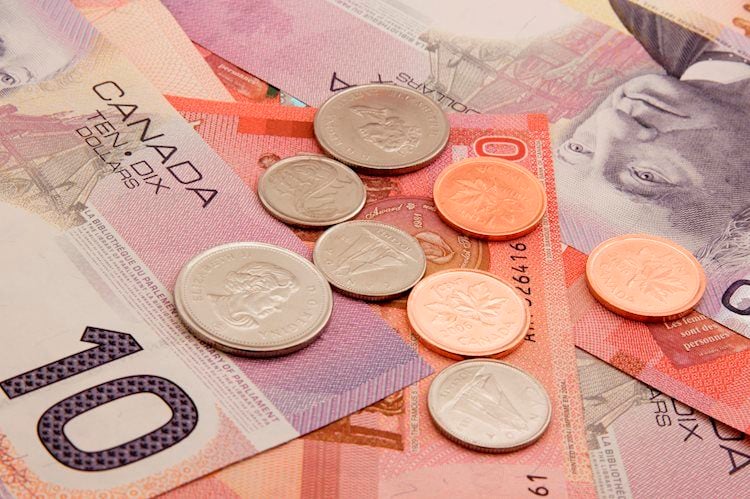
- Canadian Dollar outflows continue for Tuesday as investors pile into the US Dollar.
- Canada PMIs, labor data still ahead later in the week, but US NFP to overshadow.
- Crude Oil prices are rebounding for Tuesday, providing limited support for the CAD.
The Canadian Dollar (CAD) continues to sink against the US Dollar (USD) as broad-market risk-off flows remain the overall theme for investors on Tuesday. Oil-dependent CAD is catching only minor support from Crude Oil prices, which are seeing a minor rebound after halting a three-day decline.
Canada has both Purchasing Manager Index (PMI) and Employment Rate figures due this week on Thursday and Friday respectively, but market impact will likely remain muted as investors jockey for position ahead of the US Non-Farm Payroll (NFP) data drop on Friday.
Daily Digest Market Movers: Canadian Dollar gives up further ground, USD/CAD probing above 1.3700
- The USD/CAD crossed the 1.3700 technical barrier early Tuesday, sending the pair to a daily high of 1.3736.
- The US Dollar remains well-bid across overly cautious markets as investor confidence shakes out.
- Rising US Treasury yields, faltering global growth outlook, supply-constrained rising Oil prices, and a short-term government funding stopgap for the US are all sending investors into the safe-haven USD.
- Crude Oil prices are rebounding after three straight days of declines as CAD tries to suture the bleed against the USD.
- Economists from several large banks are starting to caution that the USD/CAD could be poised for a rebound if market flows ease up.
- Economists at Scotiabank noted that a firm showing for Canada data this week is needed to bolster expectations of another Bank of Canada (BoC) rate hike.
- MUFG Bank economists don’t see the USD/CAD pair returning to the 1.3600 region until the end of the fourth quarter.
- The US-Canada rate differential remains the key theme to capping USD/CAD chart flows according to HSBC analysts.
Technical Analysis: Canadian Dollar hits 1.3736 as markets extend the risk-off dogpile into US Dollar
Canadian Dollar (CAD) selling peaked at an intraday high of 1.3736 in Tuesday trading, and US Dollar bulls are looking to build out a price floor from the 1.3700 handle.
The USD/CAD has risen nearly 2.5% since last Friday’s dip into 1.3417, where the pair saw a technical rejection from the 200-day Simple Moving Average (SMA).
A continued run up the charts will see the USD/CAD set for a challenge of 1.3860, a region that the pair hasn’t seen since March.
Hourly candles have the USD/CAD drifting steadily higher as short interest fails to push the pair back into the 34-hour Exponential Moving Average (EMA). Bullish momentum appears to be running out of steam, and the Relative Strength Index (RSI) is drifting out of overbought territory.
Sellers will want to build up enough momentum to send the pair back down to 1.3560 near the 100-hour SMA, while bidders will be looking to mark a new high for the day beyond 1.3736.
Bank of Canada FAQs
The Bank of Canada (BoC), based in Ottawa, is the institution that sets interest rates and manages monetary policy for Canada. It does so at eight scheduled meetings a year and ad hoc emergency meetings that are held as required. The BoC primary mandate is to maintain price stability, which means keeping inflation at between 1-3%. Its main tool for achieving this is by raising or lowering interest rates. Relatively high interest rates will usually result in a stronger Canadian Dollar (CAD) and vice versa. Other tools used include quantitative easing and tightening.
In extreme situations, the Bank of Canada can enact a policy tool called Quantitative Easing. QE is the process by which the BoC prints Canadian Dollars for the purpose of buying assets – usually government or corporate bonds – from financial institutions. QE usually results in a weaker CAD. QE is a last resort when simply lowering interest rates is unlikely to achieve the objective of price stability. The Bank of Canada used the measure during the Great Financial Crisis of 2009-11 when credit froze after banks lost faith in each other’s ability to repay debts.
Quantitative tightening (QT) is the reverse of QE. It is undertaken after QE when an economic recovery is underway and inflation starts rising. Whilst in QE the Bank of Canada purchases government and corporate bonds from financial institutions to provide them with liquidity, in QT the BoC stops buying more assets, and stops reinvesting the principal maturing on the bonds it already holds. It is usually positive (or bullish) for the Canadian Dollar.